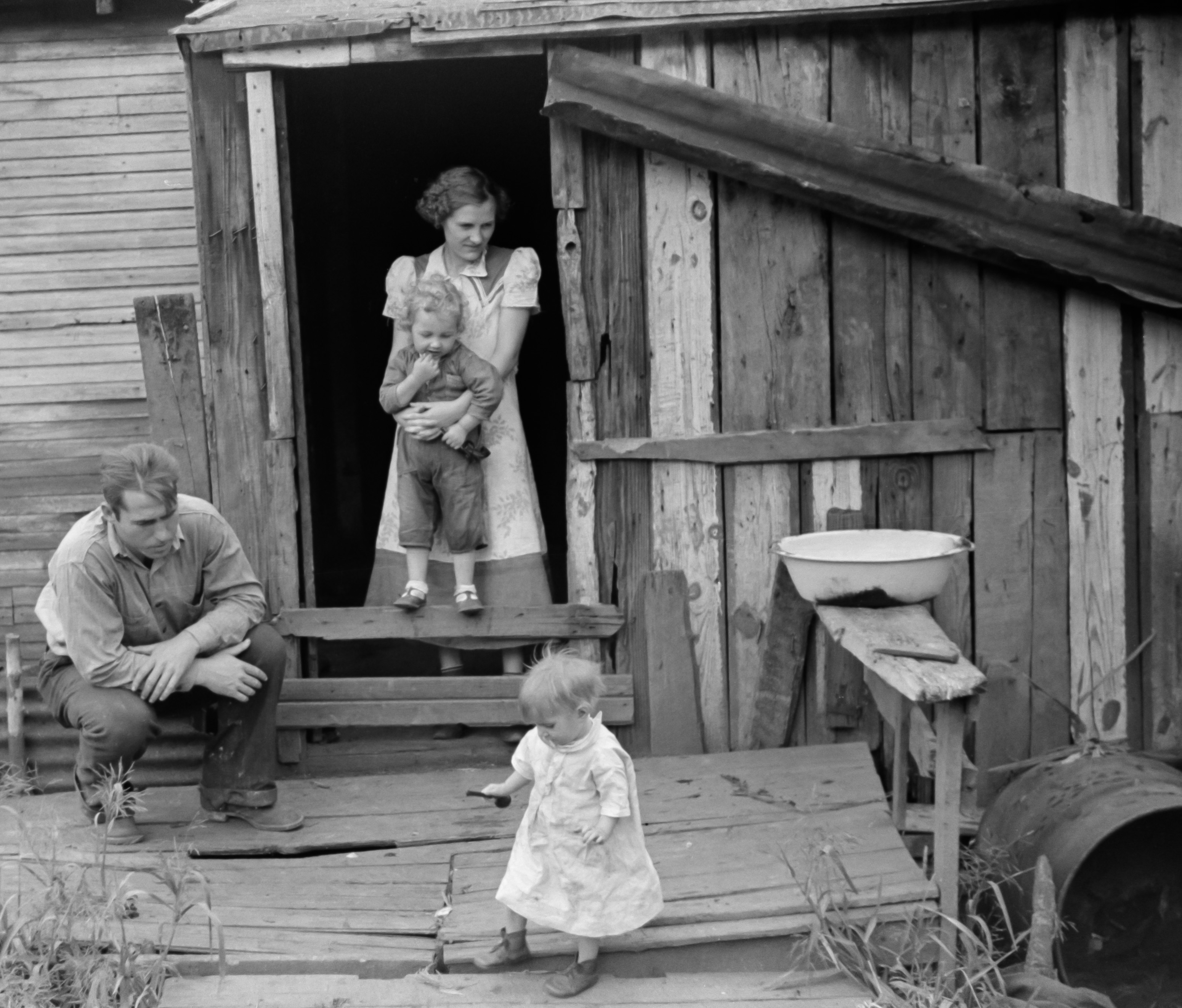
Memory and Change—The Good, Bad, and Ugly: Part I
Here is a topic for which my blog title seems most appropriate, “Memory and Change.” How so much has changed over my lifetime—and how hard it is to remember. The acceleration of those changes has increasingly been most difficult to assimilate. And it does seem that one’s ability to adjust to change decreases as one ages. I am 86 years old, and even that objective fact is difficult to comprehend. What happened to me in these last 86 years? Where did they go? What did I do? How did the world change? At my age, remembering the past is increasingly difficult, but still, some memories are there.
I found an interview I recorded with my 102-year-old mother in 2014, a few months before she died, in which she describes the birth of each of her eight children and many of the events described below. During 1933, we lived in a shack on a uncle's farm, and that is where my brother John was born. This was during the worse part of the Great Depression.
Listen to my 102-year-old mother talking about the shack and the living conditions:
We lived in various other houses, usually in the country somewhere. Meanwhile, dad worked all over, including out of state. He was also seriously injured on the job at one time, being electrocuted while working on a crane. He fell into a creek and was hospitalized for weeks.
Chicken Dinner
I have a vivid memory, at about 6 years old, of being put outside while my mother mopped the floors. I did not want to go outside and objected. She was firm. So I issued a threat.
I remember that when we wanted to have chicken for dinner, my dad would go out into the yard, grab a chicken, and holding the chicken by the head, swing it around and around until he pulled its head off. Then mom would clean the chicken and cut it up, and we would have chicken for dinner.
Well, so what was my threat unless she let me back in the house? I said, “If you don’t let me in, I am going to kill a chicken.” Mom laughed and said, “Go ahead.” So I chased a chicken around the yard, caught it, and did what I learned watching my dad. I tried to wring the chicken’s neck off, but failed. Mom, hearing the commotion, came outside and finished the job, and we had chicken again that evening.
She still did not let me into the house.
Listen to my mother describe this event.
Building a House
My dad was an itinerant construction worker, so he had to go where the jobs were. Specifically, he was an ironworker. He could do three different kinds of work, structural steel erection, ornamental ironwork, or placing reinforcing iron (rebarb) over which concrete was poured.
When dad worked, we were okay, but when there was no work or the weather did not permit outside work, we had no income. (Unemployment benefits came only after the passage of the law in late 1935, and nobody collected anything until mid-1936.) We had never owned a home and were very poor.
In 1938, in the midst of the Great Depression, when I was 7 years old, my dad bought an acre of land “on payment,” about $10/month for 5 years or so in the western part of Kansas City, Kansas. He had plans to build us a house.
Dad said we had to build a garage first, and we could live in the garage while the house was being built. He would dig a pit and build an outhouse as a toilet.
So dad bought some lumber planks, sawed them into the right shapes, and nailed those pieces of wood into forms to make concrete blocks. He borrowed a hand-cranked concrete mixer and bought cement, sand, and gravel.
I can vividly remember my older brother and me helping dad, as we mixed the concrete, poured it into forms, and after the concrete “set up,” lifting the forms off and carrying the newly made concrete blocks over to where dad was building the garage. (My brother, Richard, was 8 at the time; my younger brother, John, was 5; and my younger sister, Marilyn, was 3.)
The garage used these homemade concrete blocks for walls, and dad laid a couple of 2 x 12 planks as the main support beams for the roof. Then he nailed down plywood as a roof and covered the plywood with tar to seal the roof from the rain. He covered the opening where a garage door would go some day with a wooden wall.
This garage, which must first serve as a home, had hanging bed sheets for walls to separate rooms; hard, clay dirt floors; and a potbellied stove for cooking and heating the house in the winter. I remember mom sweeping the dirt floors. The dirt was so hard that it was like sweeping a wooden floor. There was no running water or electricity. We had a well nearby for water, and we used coal oil lamps for light at night. Water was heated on the stove, and once a week we could get a bath in a metal tub. I cannot remember owning a toothbrush, and none of us had ever been to a dentist.
We had a wonderful “police dog” called Teddy. He was gentle and friendly to everyone, but he was big and strong. He would even allow me to ride on his back. We loved Teddy.
Off to Find Work
But after about a year or so, dad had no work in Kansas City. We had no money, and our situation was quite serious. I do remember not having any shoes, and a teacher in my school bought shoes for me to wear.
Dad heard that there was a big job in Denver. He was always looking for "big jobs," a job that might last at least a couple of months to a year. He went out to Denver without the family for a while, but then decided to come back and get us.
We had no car, but one of dad’s friends, Bill Allen, owned a 1930 Pierce Arrow Model B, which was big and had a trunk. So Bill, his wife, and dad drove back to get the four of us and mom.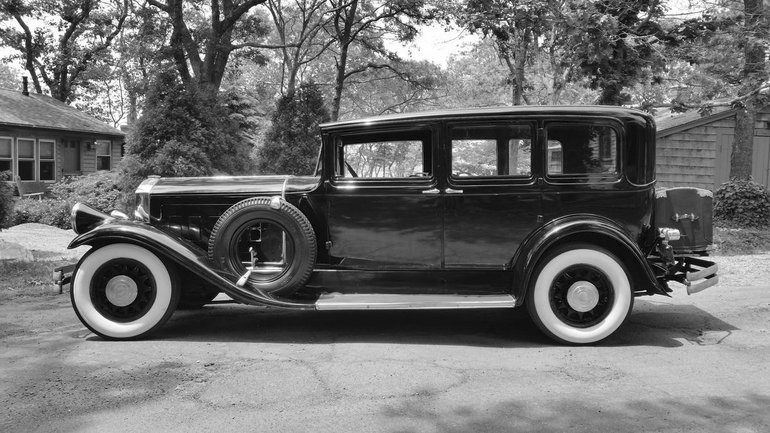
On Memorial day, May 31, 1940, dad and mom loaded what little could be taken with them, along with we three boys and my sister, and left everything else. With Bill Allen and his wife—seven people total, plus all of our worldly possessions—we drove back to Denver where the job was located. Mom was pregnant, and on June 25, 1940, would deliver our second sister, Marcia.
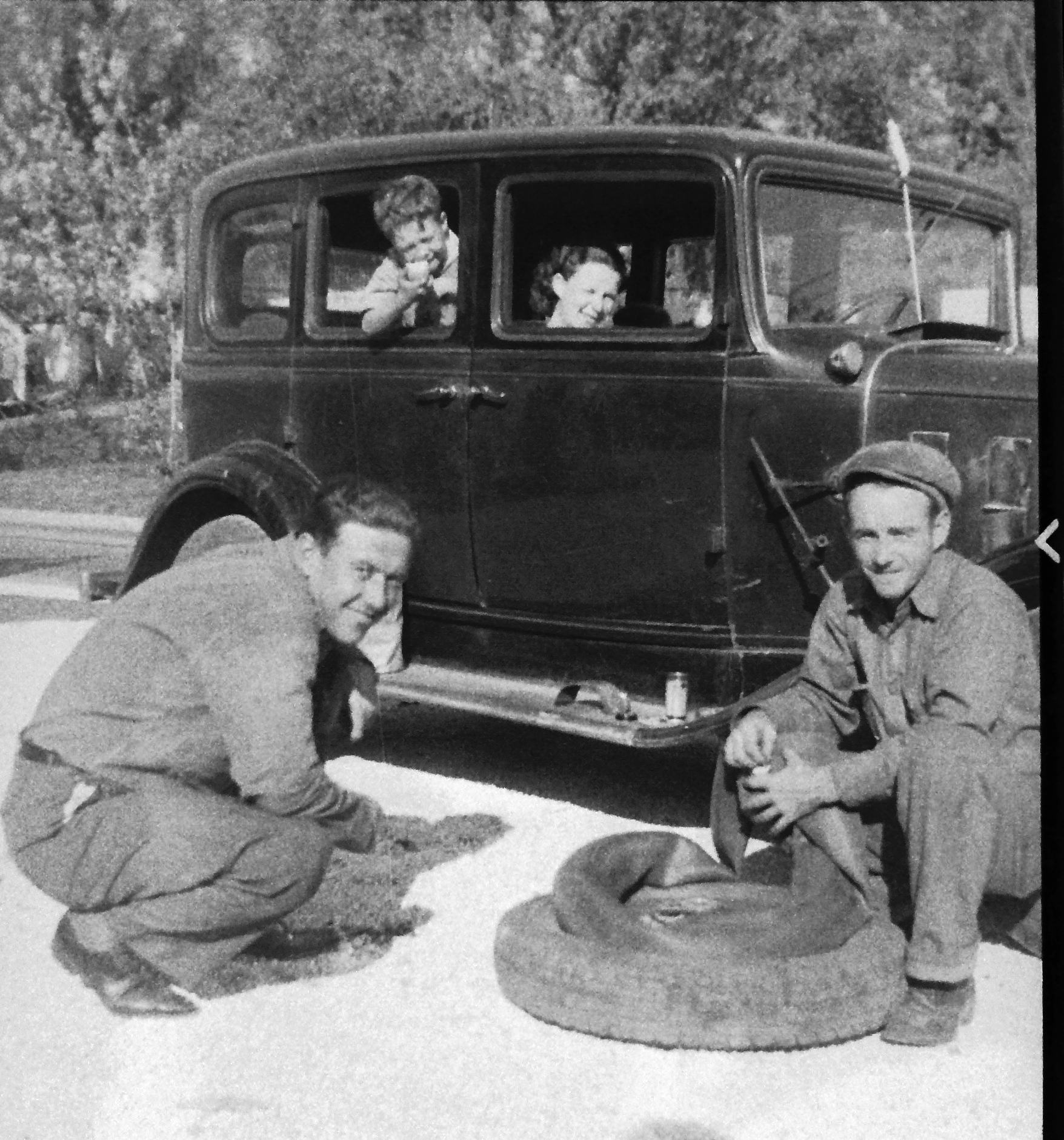
Dad is on the right; Bill Allen is on the left. That is me looking out the window, and Bill Allen's wife, whose name I do not remember. Yes, this is a 1930 Pierce Arrow.
This was our family from the census of 1940, shortly before we left for Denver.
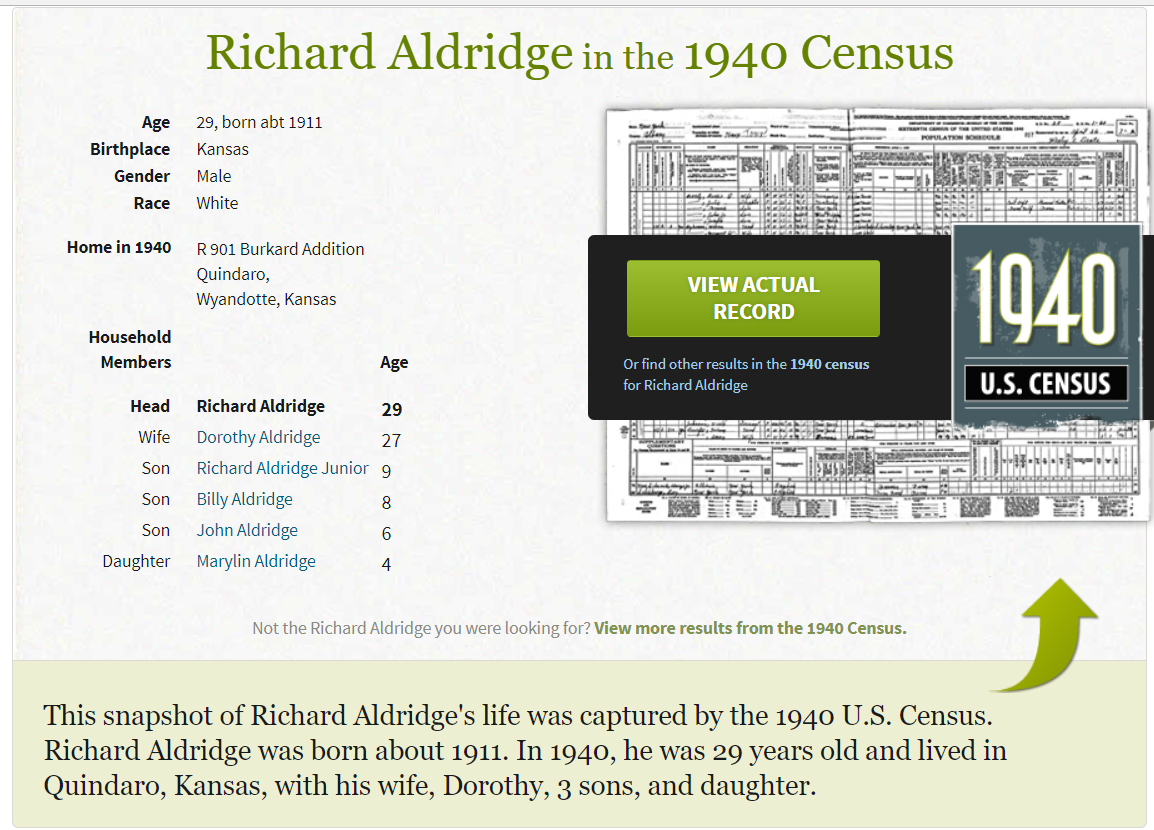
We had left all of our furnishings, and we had left the house and land. Dad and mom just abandoned the property and turned it all back over to the people from whom we were buying it “on time.”
But we also had left Teddy, our dog!
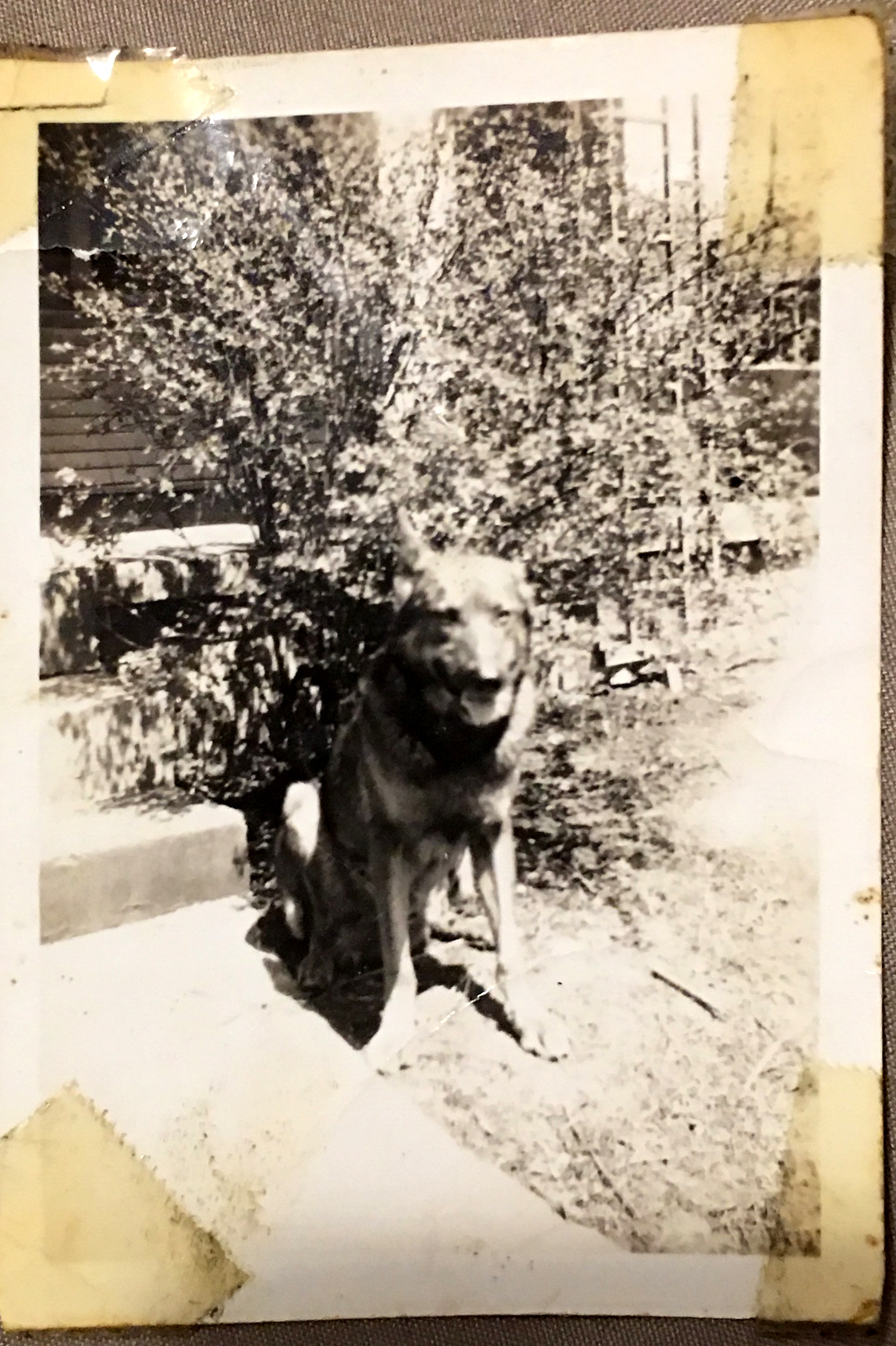
This was Teddy on April 17, 1937. At that time we lived at 2730 Kimball St, Kansas City, Kansas, and I would have been in kindergarten at Quindaro School, and would have lived within 3 blocks of Alice Hazen, who I had not thought I had met, because I did not meet her until grade 9 of high school. We were married on April 22, 1950. But she would have been in my class at Quindaro. My family would therefore have moved to build the house the next year, 1938, when I was six years old (before December 16, my birthday).
I was never ever able to forget Teddy. I had dreams where he was there with us, but never upon awakening. Years later I tried to find out what had happened to him. But I found nothing.
Making Coal and Playing the Piano
When the job ended in Denver, dad found other work in Texas. So off we went to Texas. Then back to Denver, and then back to Texas, all in one year. By this time, we owned a car, and mom would sometimes be driving us places, often in the mountains.
When we drove in the mountains, nobody wanted to sit on the side of the car that would overlook the drop-off from those narrow mountain roads.
Our time in Denver was strange. My old grade cards showed that we were there for part of one semester; then I have a grade card for Alvin, Texas; and then another grade card for later in that same year, back in Denver.
We were in Texas on two occasions, first renting an old farmhouse. We lived on the ground level, and some friends lived upstairs. I remember the upright piano, and that I was able to find notes to play that matched music I had heard on the radio. I loved to try to play the piano and was so pleased when I could play a tune. Of course nobody would even have thought about me having lessons. There would be no money for anything like that.
When not trying to play the piano, I would play in the front yard drainage ditch. While there once, I packed mud around a piece of wood and buried it in the ditch. A few days later I wanted to see if it had yet turned into coal. It had not.
Living in the Tents
I was 11 years old during part of 1942 when dad was working at a refinery being built in Texas City.
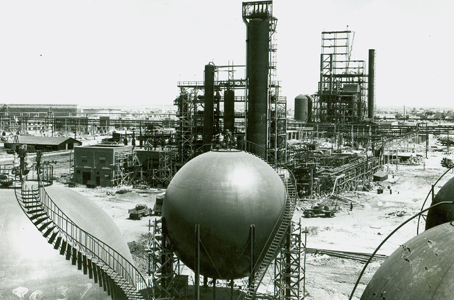
Photo shows first refinery, out of two dad worked on.
This was a big job, and since all of my uncles, my grandfather and my dad, and their friends, were all ironworkers, there were jobs for all of them. So many went to Texas City, the men and their families, and the men quickly erected flat wooden platforms on land rented from a farmer outside of town. Tents were then placed onto the platforms, making each tent a small house. Our big tent was home to my family of 6, and my Grandparents and one of their sons.
So here we were, a clan, if you will, all living in tents. The school bus would come in the morning, and at our stop, all of the kids of all of the families would board the buses. After school, the buses returned us to our tent city. We kids were always so embarrassed that we were the tent people.
Music of the 1930s
Music has always been around us. When I was a child, we heard it played mainly on the radio. Sometimes we saw a person playing a guitar, violin, or piano, but almost never did we see a group of people playing music. We never went to church, and as far as I know, no one in my family was religious.
So what was that music? The big bands, the singers, which are now all gone. Louis Armstrong, Glen Miller, Fats Waller, Bing Crosby & the Mills Brothers, the Boswell Sisters, Connie Boswell, Ella Fitzgerald, Don Redman, the Spirits of Rhythm, Chick Bullock, Louis Prima, Henry "Red" Allen, Mildred Bailey, Ivie Anderson, and of course, Billie Holiday.
Click on the following link, and listen.
Music in the 30s
Movies of the 1930s
As kids, we did get to go to movies, which were cheap. I think it was a way for mom and dad to get us out of their hair for a while. Most often we would go to a matinee, with a double feature and cartoons. So with a news section, we would be in the theater for 3 or 4 hours. Here is a list of movies I saw, their release dates, and their popularity ratings.
- Gone with the Wind (1939)
- The Wizard of Oz (1939)
- King Kong (1933)
- Snow White and the Seven Dwarfs (1937)
- Frankenstein (1931)
- Dracula (1931)
- Stagecoach (1939)
- The Adventures of Robin Hood (1938)
- Union Pacific (1939)
- It's a Wonderful World (1939)
- Bride of Frankenstein (1935)
Books and Magazines
We never read books. Dad would read True Detective, and we would sometimes look at the illustrations of dead people and become frightened.
But there were no books in the home.
We did have Reader's Digest and Life Magazine. These were our source of reading, and they had photos and illustrations.
And of course we had comic books. I should be wealthy today, had I kept those first-edition comic books we routinely threw away.